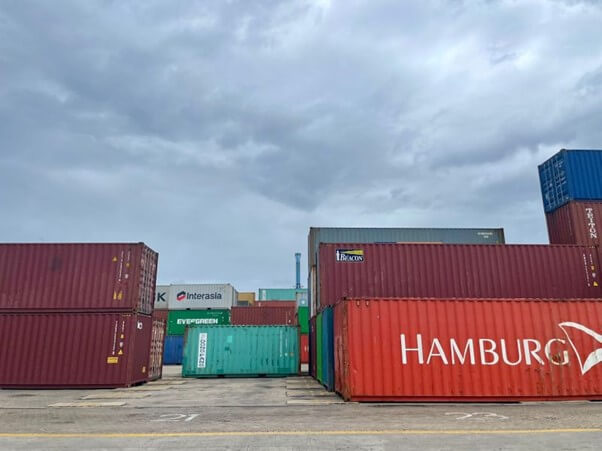
Our Projects are
Transforming African Trade
Quick Contacts
2nd Floor, Fidelity Insurance Centre Waiyaki Way, Westlands

Do you know where the avocados, pineapples and mangoes you see at the store come from? What about the roses and bouquets of flowers you buy for your loved ones?
If you live in Europe, there’s a good chance these products came from East Africa and left the port of Mombasa in southern Kenya.
Most goods from landlocked East African countries must pass through the Kenyan port city of Mombasa. This is where trucks from Uganda, Tanzania, the Democratic Republic of Congo and many other countries unload their cargo onto ships bound for Europe.
The port of Mombasa therefore allows the continent to open up to the international market. Its strategic location attracts many investors, such as the European Union and also China.
Europe is Mombasa’s “main market for fresh produce and flowers”, the port’s general manager, Captain William K. Ruto, told Euractiv. The Dutch port of Rotterdam accounts for 70% of traffic, he said, followed by ports in the United Kingdom, Germany and France.
Currently, exports outnumber imports, but Kenya is looking to boost both as it wants to secure a trade deal with the EU and be more competitive internationally. To do this, it needs to modernize its main port in order to be able to process large quantities of goods more quickly. The goal is to export 50% of Kenya’s fresh produce by sea by 2030.
For the EU, investing in trade routes is a matter of economic development and a way to promote a more environmentally friendly maritime trade route than air freight, according to EU experts.
This is why the EU and its Member States are investing in the “Northern Corridor”. This strategic trade route, identified as such by the African Union, begins and ends at the port of Mombasa and connects the Great Lakes region (Burundi, Democratic Republic of Congo, Rwanda, South Sudan, Uganda and Kenya) to the rest of the world.
To make sea freight more attractive and trade routes greener, the transit time between farmers’ fields and the European supermarket must be as short as possible and therefore go from a few weeks to a few days. With shorter waiting times, flowers could also have time to reach Japan, Australia and the United States, for example.

To reduce transit time, “the most important thing is digitalisation and automation of processes wherever possible to improve efficiency and minimise human interference, thereby eliminating corruption and all the hassle,” Ahmed Farah, Kenya director of TradeMark Africa, a non-profit “aid for trade” organisation, told Euractiv.
“We want technology and training” for farmers and truck drivers so they can use this technology, Mr Ruto said, when asked what he expected from his partners to achieve this ambitious goal.
Significant European investments have already been made in the port of Mombasa.
During a visit to the port, the port authorities showed Euractiv the two-way road that had been built thanks to these investments, which facilitates traffic and the speed with which goods trucks pass. Previously, this road had only one lane, which caused traffic jams.
Additionally, avocado shipments from Tanzania can now be tracked throughout their journey using EU-funded electronics and technology.
China’s presence is also very visible in the port. Beijing has, for example, invested in scanners that identify cargo and in a standard gauge railway line from Mombasa to Nairobi. This line will transport cargo between the port of Mombasa and Nairobi, and will soon be extended to Uganda, South Sudan and Rwanda.
From Nairobi airport, you have to take the expressway to reach the city centre. This new road built by China and completed in about a year, a record time for a 27-kilometer-long highway, would have reduced traffic times from two hours to 30 minutes.
China’s Silk Roads initiative, celebrating its 10th anniversary, plans infrastructure projects connecting China to 150 countries with roads, bridges and 5G networks. In view of these objectives, it seems difficult to avoid comparison with the EU’s efforts under its “Global Gateway” strategy, launched two years ago.
This strategy, worth 300 billion euros, aims, among other things, to offer developing countries an “alternative” to the Chinese New Silk Roads.
With “Global Gateway”, the Europeans want to offer a more transparent alternative and favours donations as part of development aid, unlike the loans granted by China as part of its New Silk Roads initiative.
However, at first glance the EU may also seem less attractive: European projects take longer to come to fruition, there are a lot of formalities and spending controls are strict.
That said, leaders of various trade associations told Euractiv that they hoped Kenya and other countries involved in the development of the Northern Corridor would prioritise the needs of commercial industry and the quality of future infrastructure financed by third countries or the EU, rather than being satisfied with their rapid development.
They asked that this infrastructure be part of the “masterplan” that constitutes the network of roads and digital connectivity that the northern corridor should become. They also suggested that some investments could be politically motivated.
Asked how they choose their partners, Captain William K. Ruto, Managing Director of the Port of Mombasa, replied: “We are open to everyone, to anyone who is willing to do business, we do not limit ourselves to one entity.”
Read original article
Disclaimer: The views and opinions expressed in this article are those of the authors and do not necessarily reflect the official policy or position of TradeMark Africa.